Violets and orange flower water
April in Collioure in the South West of France, army frogmen, the French for razor clams and an Easter recipe for Bunyetes.
Thank you so much for subscribing and for being here.
"There is nowhere else in France a sky with a deeper blue than the sky of Collioure…"
HENRI MATISSE
Out of the corner of my eye I can see a carpet of violets, their delicate heads bowed down to face the grass, a few bashful petals raised towards the sky. The splendour is best appreciated from a distance; close up the depth and richness fades to speckles of spread out colour.
Violets always make me think of my passion for floral flavours, from the deeply unfashionable parma violets, and floral gums to candied violets, and the best violet fondants in the world from the centuries old Romanengo in Genova and Milan. Norman Hartnell was supposed to have said; ‘I have a vulgar passion for violet cremes.’ I’m in good company. They also make me think of Collioure.
I’m taking you back a few years. A Summer’s day trip from Toulouse. I left my friends behind in the steaming city and took a rambling train to the legendary Côte Vermeille, to Collioure, where I’d read about the impossible clarity of the sky. Sadly, I was no pioneer; thousands of other people had discovered it before me, and there they all were, swarming through the narrow streets and crowding the beaches. The mass of tourists did nothing to take away from the light though. It was true; it was dazzling.
Fifteen years later, I returned. No car and a train strike left me at the mercy of the daily buses from Perpignan. And two weeks to discover and forage for food.
Every April I remember the scent of orange flower water, the taste of violet ice cream and the breathtaking beauty of Collioure. Why does this memory resonate with me so much? Its sweet notes are tinged with bitterness. At a time when my stress levels were like a rumbling volcano I ran away to Collioure. Half way through my holiday I went to Perpignan for the day. A migraine developed, built and peaked to the point where I had to return to my flat to try to sleep away the pain and sickness. When I awoke twelve hours later, the migraine was gone, but tinnitus had taken its place. It’s been with me ever since. Ironically, this was a time when a volcano had erupted in Iceland and flights were delayed. I try my best to remember the violets, the blue sky, the sweetness.
Collioure is only 20 minutes from Spanish Catalonia with menus displaying French and Spanish influences. Its streets are full of small restaurants, art galleries, souvenir shops and chic boutiques. A horseshoe shaped bay, Our Lady of the Angels Church dominates the north, with the Medieval Royal Castle of Collioure taking its rightful place in the centre of the quayside, overlooked by colourful boats. Between the church and the castle, the plage de Collioure is the busiest beach. The beaches to the west are quieter.
Henri Matisse painted pictures of the quay side and village which pulsated with light and colour and Patrick O'Brian, the author of nautical tales, made it his home for 50 years. It is no longer an active fishing village but its beauty has not faded.
It’s not peak tourist season yet. Schools haven’t broken up, the sea still has an edge of chill to it and I can have the beach to myself. The cafes are full of local people claiming their right to their favourite spots.
My first foray for food is disappointing; the local shop is bare of fresh produce, and I couldn’t remember how to ask for sourdough bread in French.
It took me a day to find the market. Held two days a week up the hill on the town square, when I arrive at 10am it is already bustling with local people come out of hiding to do their shopping.

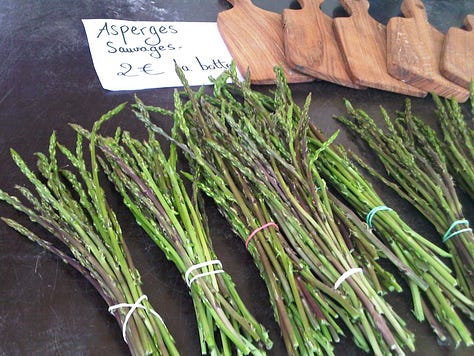
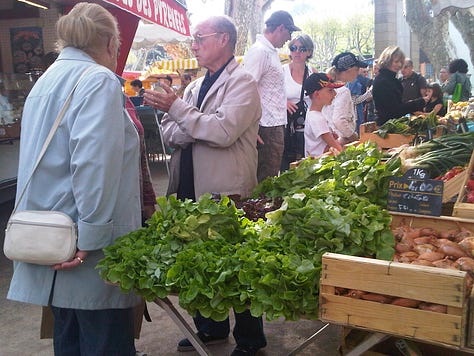

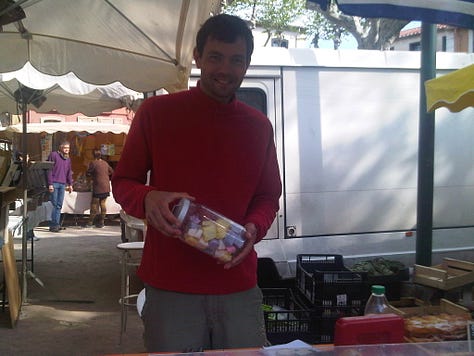
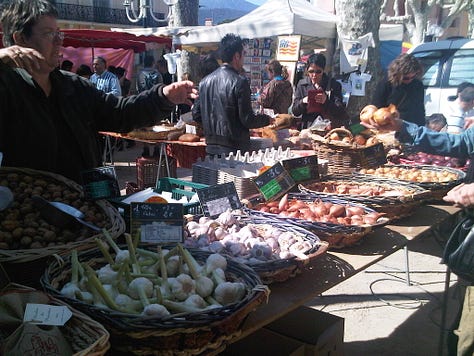
On this particular April morning there are fresh local cheeses, herbs & salad leaves, the first tender little broad beans, bunches of salad onions large enough to braise.
A group of shoppers have gathered around a man who has brought a basket of sea urchins he's dived for, cutting one of the black spiky specimens open to sample. A meat van has a display of the local sausages, cured meats & rabbits. Bread stalls are covered with huge crackling loaves, threatening to over balance. They're cut & sold by the kilo. There are baskets of beautiful rose hued bulbs of garlic, and slender banana shallots. A biologique stall displays eggs, huge artichokes and strings of onions.
Nestled between, there are men selling the first strawberries of the season; two varieties one small & pointed, the others a deeper red, large & overflowing their little baskets. I breathe in the scent and buy a punnet of the smallest for my breakfast. Radishes are selected, still with the earth on their red & white heads; craggy local tomatoes, creamy waxy potatoes perfect for a salad.
French produce is labelled with its place of origin. Otherwise it’s clearly labelled; Italy, Morocco, Spain.
Local women set up stalls with bunches of local herbs and salad leaves which disappear rapidly from their carefully arranged baskets.
The price of the asparagus almost takes my breath away. A woman next to me shopping with her wicker basket full of mussels says 'plus chere' & it is. The stallholder answers, ‘first of the season madam’, but there’s slender spru too, spiky bunches of it, much cheaper than the first fat spears of the season.
Just as I'm leaving I spot a jar of coloured marshmallows on a tiny unassuming patisserie stall. Are they rose & violet I ask hopefully? They are. Orange flower water flavoured too. Wonderful; made by the stall holders’ girlfriend, a pastry chef. I’m offered samples; it would be rude to refuse. It’s equally difficult to resist eating them all at once.
A pain au raisin overlooking the sea; the harbour coming to life with of all things, army frogmen landing on the beach. My deeply scented strawberries and violet marshmallows won’t last until the next market day.
Collioure is a small village. There are at least five bakeries. One has the sweet aniseed flavoured bread I bought on my first day trip. The morning trip to the baker becomes a welcome routine.
The butcher is yet to be found open. Two greengrocers seem to pander to tourist tastes rather than local needs. No fishmongers that I can find.
At the entrance of the traiteur on a flat wicker tray are a pile of what look like flat sugared doughnuts. They're the local speciality of the Perpignan and Catalan region called Bunyetes, flat, fried yeasted ’pancakes’ which swell in oil, become crisp, and are served dusted with granulated sugar, much like beignets or doughnuts. Flavoured with orange flower water, Bunyetes are traditionally made and eaten at Easter all over Catalonia.
They're delicious; subtly orange, light, non greasy. Perfect for a slightly windswept day.
All over the town there are reproductions of paintings at the locations they were created, with frames for you to view the scene. Picasso, Derain, Dufy, Chagall & Charles Rennie Macintosh all came here, drawn by the clarity of light.
A dozen ice-cream parlours near the harbour and beach have brazen luridly coloured confections heaped up in piles like beehive hairdos in bubblegum shades.
In the back streets is an artisan shop specialising in Catalan confectionary including La Rousquille, a simple Catalan biscuit, flavoured with lemon and aniseed, topped with a layer of meringue. Their glace and sorbets are hand made and amongst the lovely natural flavours (fig, sheep’s milk yogurt) violet is delicate and subtle. Candied and glacé fruit, and various types of nougat are sold by the gram.
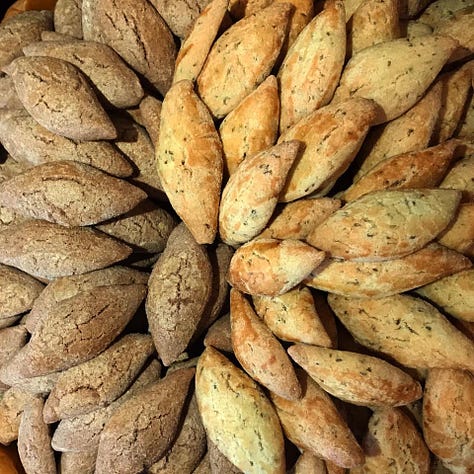

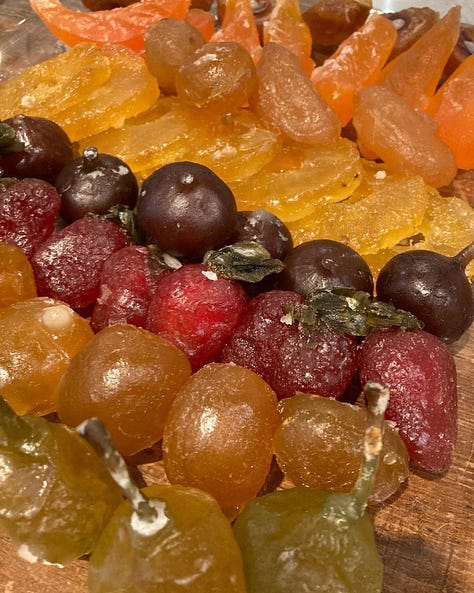
Saveurs d'Antan 4 Rue Pasteur Collioure
In another back street I stumble across a traditional Catalan biscuit shop where the divine crisp almond, cinnamon and aniseed croquant biscuits are made on site to a secret family recipe (it’s always a secret family recipe). Once I’ve returned home, my friends exclaim at their deliciousness and I wish I’d brought more. Naturally I can’t get the recipe but ground almonds and egg white figure highly.
Le Croquant à l'Ancienne. Spécialité de la Famille Pons. 8 Rue Berthelot Collioure.
In Medieval times Collioure’s reputation revolved around the salting of anchovies, sardines and tuna. Salting is a hard way of making a living and, generation by generation, the anchovy salting families have become fewer and fewer. In 1870 there were 140 boats and 800 fishermen. Now, in Collioure, only two anchovy salting families remain to perpetuate the ancestral tradition of preparing anchovies in the Colliourencque way; the Roque and Desclaux houses. Anchois Roque, dates back to 1870.
Fresh Anchovies are salted whole by hand, fresh from their arrival in port.
They are left in salt, producing their own brine with their juices. Rinsed after a few days, they are then again preserved in salt for three months in order to give the anchovies their unique flavour. The skill and artistry with which the anchovies are arranged in their jars and indeed the entire labour intensive production line should ensure a heightened appreciation of the fiddly little fish. They emerge from the jar plump and full of flavour.
Once again I wish I’d bought more; I’ve not come across any anchovies like them.
Desclaux anchovy salting workshops Collioure www.anchoisdesclaux.com
Roque anchovy salting workshops Collioure
www.anchois-roque.com
The anchovy shop; Maison Roque. 17 Rte d'Argeles
Sea food is a speciality of the area; I spent an inordinate amount of time trying to find the name for razor clams before giving up and pointing to a dish on a customers’ plate. It’s couteaux (knives). This was after negotiating with the waiter in a busy restaurant for a place without a reservation. Being helpful I said that I’d be happy to share a table. ‘This’ the waiter told me firmly, ‘isn’t England’. I got my table and my couteaux eventually. They were delicious.
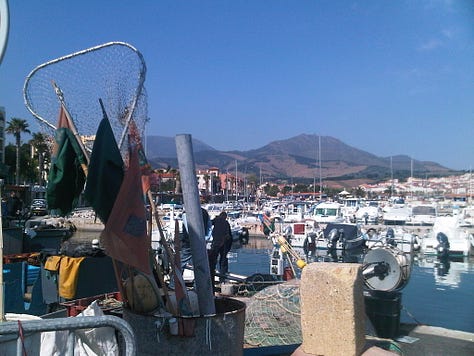
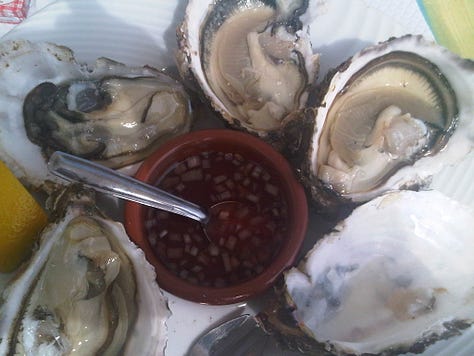
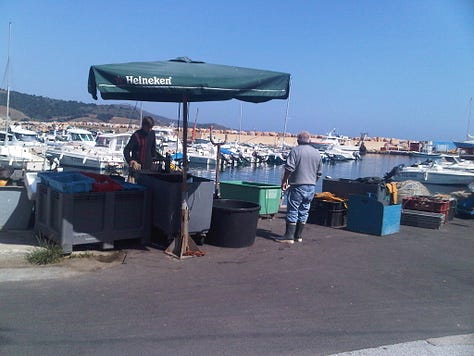
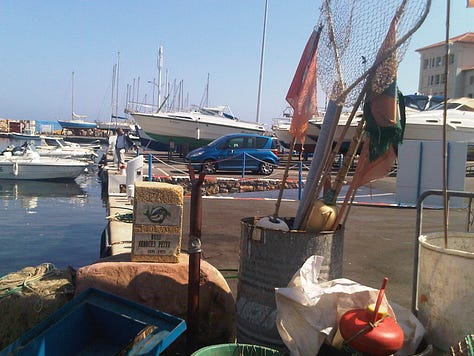


Along the coast in Port Vendres, fishermen sell their morning catch at little tables on the quayside. The numerous seafood restaurants are kinder in price than those in Collioure and many serve a reasonably priced set lunch.
The butcher in Collioure finally opened on my last day. He’s happy to offer tasters of the locally made salamis, I’m equally happy to buy.
Boucherie Jamme, 25 Rue Pasteur
La Guinelle
It’s worth seeking out the vinegar made by Nathalie Herre, the vinaigrière.
(Saint Sebastian Street, near the Market Square)
The rare white vinegar of Banyuls, the red, with scents of red fruits, and the Vermeil spicy cinnamon and cloves (for desserts).
All of her vinegars are organic and sulfate-free, made outdoors in oak casks.
Look out for Ceret cherries in spiced vinegar.
One I missed; Olivier Bajard ; 16 rue de la République
All this in one little village. And that's without mentioning the caves, wines and the local fortified wine, Banyuls.
The tinnitus is unlikely to ever leave, alas, but neither are the memories of the light.
Bunyetes (pronounced bougnet)
Catalan tradition dictates that the bunyete be stretched over the knee.
Gather together a party of willing volunteers;
1 1/2 teaspoons instant dry yeast
4 Tablespoons butter, melted and cooled
4 eggs
A few drops orange flower water
1 Tablespoon lemon zest, grated fine
1 lb all-purpose flour
1/4 teaspoon salt
1 litre of good vegetable oil
Fine white sugar
Mix the yeast with the cooled butter to dissolve it.
Beat the eggs well with the orange flower water.
In a large bowl, incorporate the two mixtures, adding the flour to make a smooth ball. If it is too sticky, add a bit more flour; if too dry, add a bit more melted butter or a little water.
Place the dough on a floured surface, and knead well, picking up the dough and throwing it down onto the surface. You cannot hurt this dough by mistreating it.
Work it until it is very smooth and elastic, as you would work brioche dough.
Place in a buttered bowl, cover with plastic wrap, and let rise until double, about 2 hours.
Divide the dough into golf ball-size pieces. Let rest, covered with a towel, for 10 minutes.
Roll out each piece of dough with a rolling pin, making the disc as thin as possible, even transparent in some places.
Heat the oil to boiling in a skillet or deep fryer wide enough to hold 2 bunyetes, or cook them one at a time in a smaller skillet. Slip the discs into the hot oil, being careful not to get burned by the splatter. When one side is golden brown and crisp, turn the bunyetes and cook the other side until golden. This will take very little time, so watch carefully that they do not burn.
Place on absorbent paper, and sprinkle liberally with sugar immediately. Bon appétit!
If you think I deserve a coffee or a glass of Banyuls for taking you to the south-west of France with me, please click here; thank you.
If you’re rushing to pack your suitcase and can’t wait to discover if Henri Matisse is right about Collioure, I do hope you’ll consider upgrading to a paid subscription. Either way, thank you for reading this far.

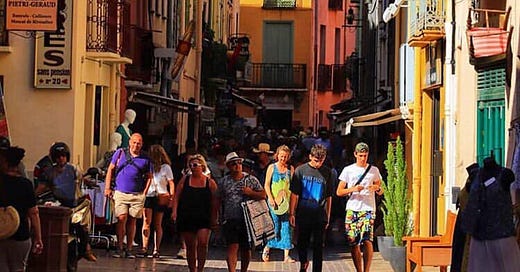








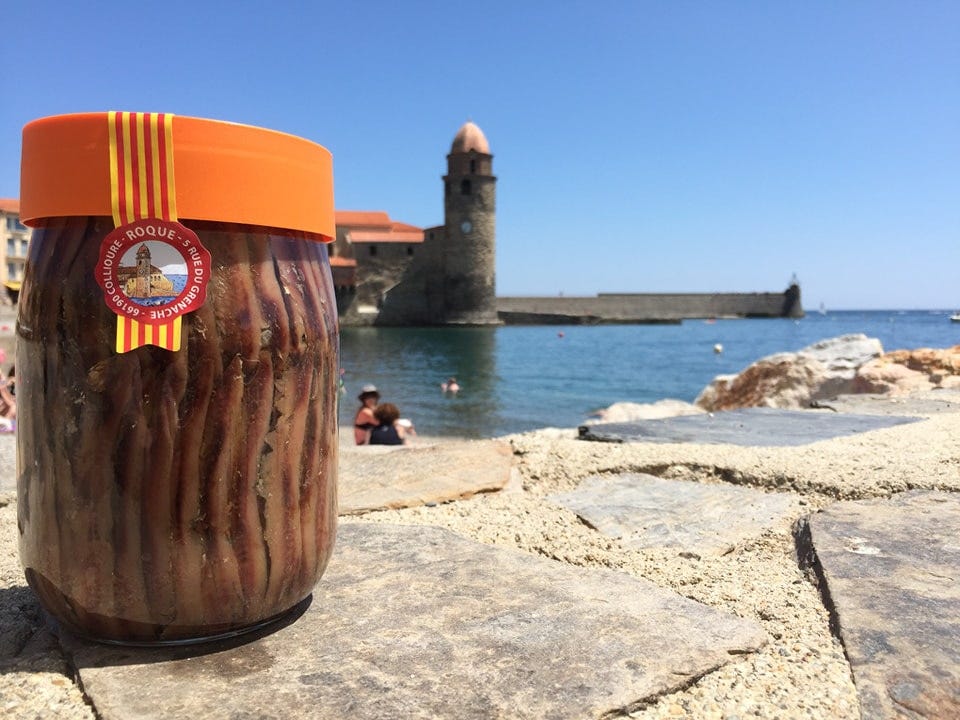

I adore Collioure especially out of season . Did you find the restaurant that is run on Slow Food principles with some very interesting dishes hidden in the centre ? I’ve eaten superbly there.
Lovely evocative piece. Love Collioure. Sadly now very overrun. But must go back !